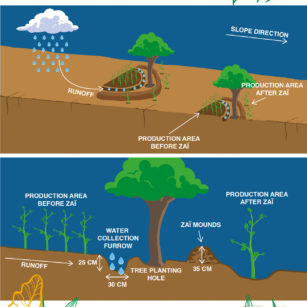


Our products
Are you interested?
Find the nearest
dealer



Our products
Are you interested?
Find the nearest
dealer
Most searched keywords:
FOCUS ON A DISEASE
RECEIVED IDEA
TIPS AND TRICKS
Preventive measures
DID YOU KNOW?


Are you familiar with the half-moon technique?
This soil management method is a real asset for arid and semi-arid regions. Inspired by traditional practices, it combines simplicity and efficiency to transform degraded land into fertile spaces!
How does it work?
Half-moons, semi-circular structures drawn on slopes, make it possible to:
Easy to implement:
Using a spade or hoe, contour lines are drawn to form embankments 30 to 50 cm high, spaced 4 to 8 metres apart. These simple structures capture water that slowly infiltrates the soil, ensuring optimal moisture for crops.
The advantages:
This technique is a solution for developing more sustainable agriculture in difficult environments

The BELAMI onion, with its spicy flavor and long shelf life, is the ideal variety to diversify your fields.
Here are some crop combinations to maximize your harvests:
Carrots: their complementary growth helps repel certain harmful insects, such as flies.
Beets: these two crops can be grown side by side, as they improve soil health.
Tomatoes: BELAMI onion can be grown with tomatoes, as the onion repels certain pests and delays the onset of fungal diseases.
The advantages of crop associations:
➔ Better resistance to pests
➔ Optimization of space and resources
➔ Diversification of crops for the fresh market
Grow smart with BELAMI onions!

Stemphylium blight, caused by the fungus Stemphylium vesicarium, is a dreaded disease of onion crops. It can lead to yield losses, especially in climatic conditions that favor its development.
Symptoms
Typical signs of stemphylium blight in onions include:
➔ At first, the spots are small, pale yellow and moist. They become elliptical, pale brown to purple in the center, often surrounded by a purple halo.
➔ Progressive necrosis of leaves, which begin to dry out as they move toward the apex.
➔ Premature leaf drop, compromising bulb development and keeping quality.
Factors favoring the disease
Stemphylian blight develops particularly well under the following conditions:
➔ High relative humidity (>80%) due to watering, dew or frequent rainfall.
➔ Moderate temperatures (18-25°C), which accelerate the spread of the fungus.
➔ Hydric or nutritional stress on plants, making them more vulnerable to infection.
Control and prevention strategies
To protect onion crops from stemphylian blight:
➔ Choose varieties that are resistant or tolerant to the disease.
➔ Remove and bury crop residues.
➔ Monitor humidity by spacing watering and promoting good drainage.
➔ Apply specific fungicides, especially during periods of high humidity.
➔ Avoid wounds on leaves, which can serve as an entry point for the fungus.
➔ Carry out crop rotation with non-susceptible crops to limit the presence of the fungus in the soil.

How to recognize a Chinense pepper?
Shape and size: Chinense peppers are often round globose or elongated globose. Their weight varies according to variety, ranging from 3 to 65 g.
Color: before ripening, peppers are green. When ripe, they take on yellow, orange or red hues, like the PHENIX variety.
Skin: often smooth and shiny, but some varieties can have a rougher texture, like the FIRE KISS variety.
Flavor and aroma: fruity, fragrant and pungent, more powerful than other types of chili, such as the ATAYINKA variety.
Cultivation and foliage: plants are generally bushier with broad leaves 🌿
Next time you come across a chili pepper, you’ll know if it’s a Chinense type! 🔥
connection
Log into the technisem CUSTOMER AREA to discover more than 500 varieties from our complete catalog
You do not yet have access to the private area of the Technisem site?
Get closer to your privileged contact within Technisem in order to receive your login details